coolant temperature SKODA SUPERB 2009 2.G / (B6/3T) User Guide
[x] Cancel search | Manufacturer: SKODA, Model Year: 2009, Model line: SUPERB, Model: SKODA SUPERB 2009 2.G / (B6/3T)Pages: 294, PDF Size: 21.33 MB
Page 120 of 294
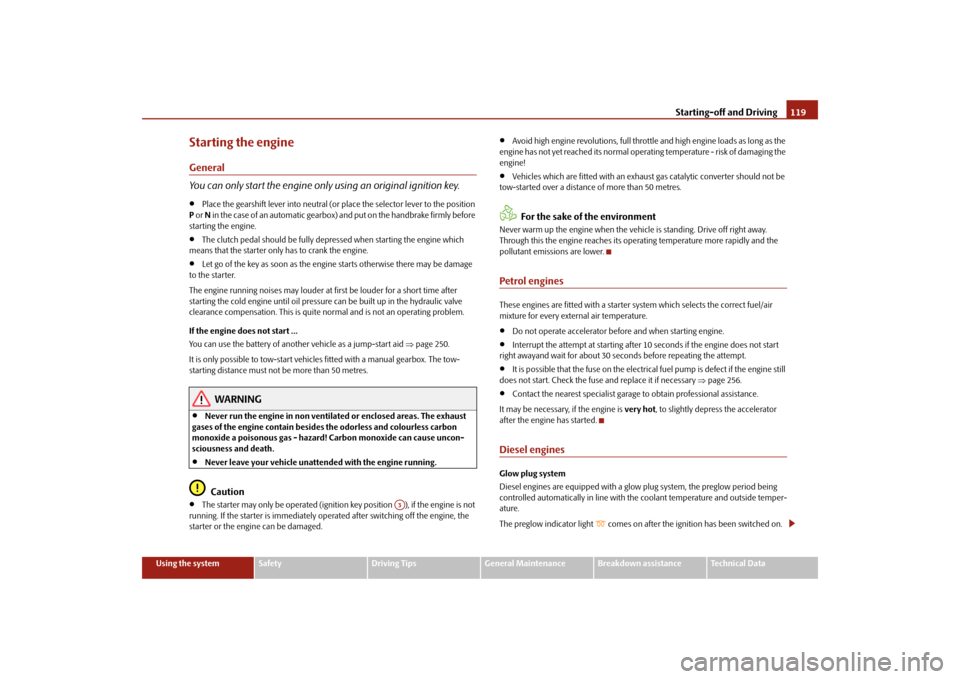
Starting-off and Driving
119
Using the system
Safety
Driving Tips
General Maintenance
Breakdown assistance
Technical Data
Starting the engineGeneral You can only start the engine only using an original ignition key.•
Place the gearshift lever into neutral (or place the selector lever to the position
P or N in the case of an automatic gearbox)
and put on the handbrake firmly before
starting the engine.•
The clutch pedal should be fully depressed when starting the engine which
means that the starter only
has to crank the engine.
•
Let go of the key as soon as the engine starts otherwise there may be damage
to the starter. The engine running noises may louder at
first be louder for
a short time after
starting the cold engine until oil pressure
can be built up in the hydraulic valve
clearance compensation. This is quite normal and is not an operating problem. If the engine does not start ... You can use the battery of anothe
r vehicle as a jump-start aid
⇒page 250.
It is only possible to tow-start vehicl
es fitted with a manual gearbox. The tow-
starting distance must not be more than 50 metres.
WARNING
•
Never run the engine in non ventilat
ed or enclosed areas. The exhaust
gases of the engine contain besides
the odorless and colourless carbon
monoxide a poisonous gas - hazard! Carbon monoxide can cause uncon- sciousness and death.•
Never leave your vehicle unattended with the engine running.Caution
•
The starter may only be operated (ignition key position ), if the engine is not
running. If the starter is immediately oper
ated after switching off the engine, the
starter or the engine can be damaged.
•
Avoid high engine revolutions, full throttl
e and high engine loads as long as the
engine has not yet reached it
s normal operating temperature - risk of damaging the
engine!•
Vehicles which are fitted wi
th an exhaust gas catalyti
c converter should not be
tow-started over a distance of more than 50 metres.
For the sake of the environment
Never warm up the engine when the vehi
cle is standing. Drive off right away.
Through this the engine reaches its operating temperature more rapidly and the pollutant emissions are lower.Petrol enginesThese engines are fitted with a starter system which selects the correct fuel/air mixture for every external air temperature.•
Do not operate accelerator before and when starting engine.
•
Interrupt the attempt at starting after
10 seconds if the engine does not start
right awayand wait for about 30 se
conds before repeating the attempt.
•
It is possible that the fuse on the electric
al fuel pump is defect if the engine still
does not start. Check the fuse and replace it if necessary
⇒page 256.
•
Contact the nearest specialist garage to obtain professional assistance.
It may be necessary, if the engine is
very hot
, to slightly depress the accelerator
after the engine has started.Diesel enginesGlow plug system Diesel engines are equipped with a glow
plug system, the preglow period being
controlled automatically in
line with the coolant temperature and outside temper-
ature. The preglow indicator light
comes on after the ignition has been switched on.
A3
s2dk.1.book Page 119 Wednesday, April 8, 2009 12:23 PM
Page 121 of 294
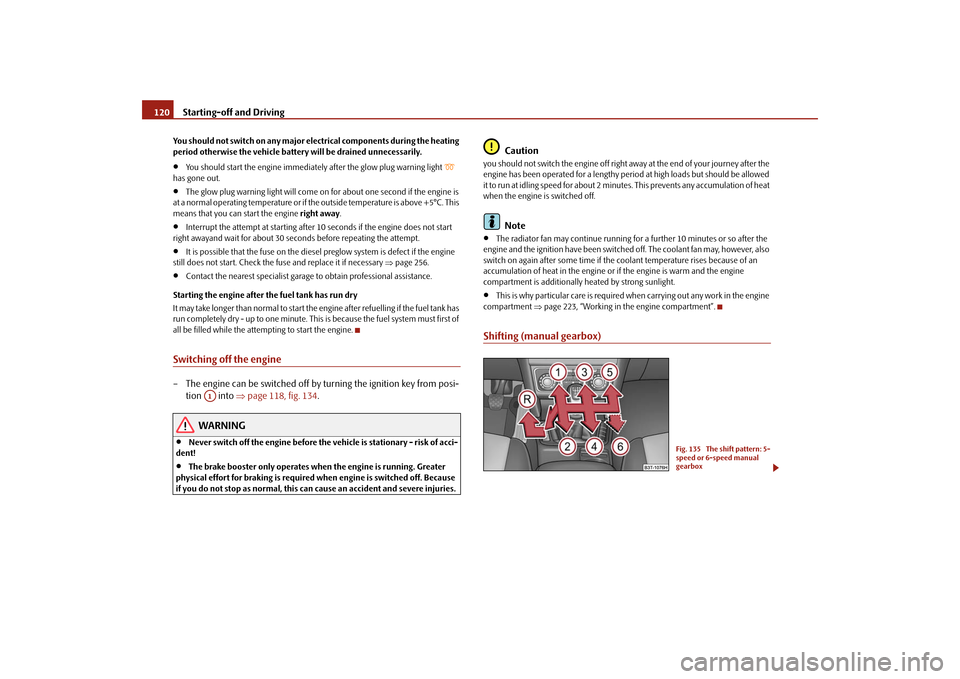
Starting-off and Driving
120
You should not switch on any major elec
trical components during the heating
period otherwise the vehicle battery
will be drained unnecessarily.
•
You should start the engine immediately after the glow plug warning light
has gone out.•
The glow plug warning light will come on for about one second if the engine is
at a normal operating temperature or if the outside temperature is above +5°C. This means that you can start the engine
right away
.
•
Interrupt the attempt at starting after 10 seconds if the engine does not start
right awayand wait for about 30 se
conds before repeating the attempt.
•
It is possible that the fuse on the diesel
preglow system is defect if the engine
still does not start. Check the fuse and replace it if necessary
⇒page 256.
•
Contact the nearest specialist garage to obtain professional assistance.
Starting the engine after the fuel tank has run dry It may take longer than normal to start the
engine after refuelling
if the fuel tank has
run completely dry - up to one minute. This is because the fuel system must first of all be filled while the attempting to start the engine.Switching off the engine– The engine can be swit
ched off by turning the ignition key from posi-
tion into
⇒
page 118, fig. 134
.
WARNING
•
Never switch off the engine before the
vehicle is stationary - risk of acci-
dent!•
The brake booster only operates when the engine is running. Greater
physical effort for braking is required
when engine is switched off. Because
if you do not stop as normal, this can cause an accident and severe injuries.
Caution
you should not switch the engine off right
away at the end of your journey after the
engine has been operated for a lengthy peri
od at high loads but should be allowed
it to run at idling speed for about 2 minut
es. This prevents any accumulation of heat
when the engine is switched off.
Note
•
The radiator fan may continue running fo
r a further 10 minutes or so after the
engine and the ignition have
been switched off. The coolant fan may, however, also
switch on again after some time if the coolant temperature rises because of an accumulation of heat in the engine or
if the engine is warm and the engine
compartment is additionally
heated by strong sunlight.
•
This is why particular care is required when carrying out any work in the engine
compartment
⇒page 223, “Working in the engine compartment”.
Shifting (manual gearbox)
A1
Fig. 135 The shift pattern: 5- speed or 6-speed manual gearbox
s2dk.1.book Page 120 Wednesday, April 8, 2009 12:23 PM
Page 210 of 294
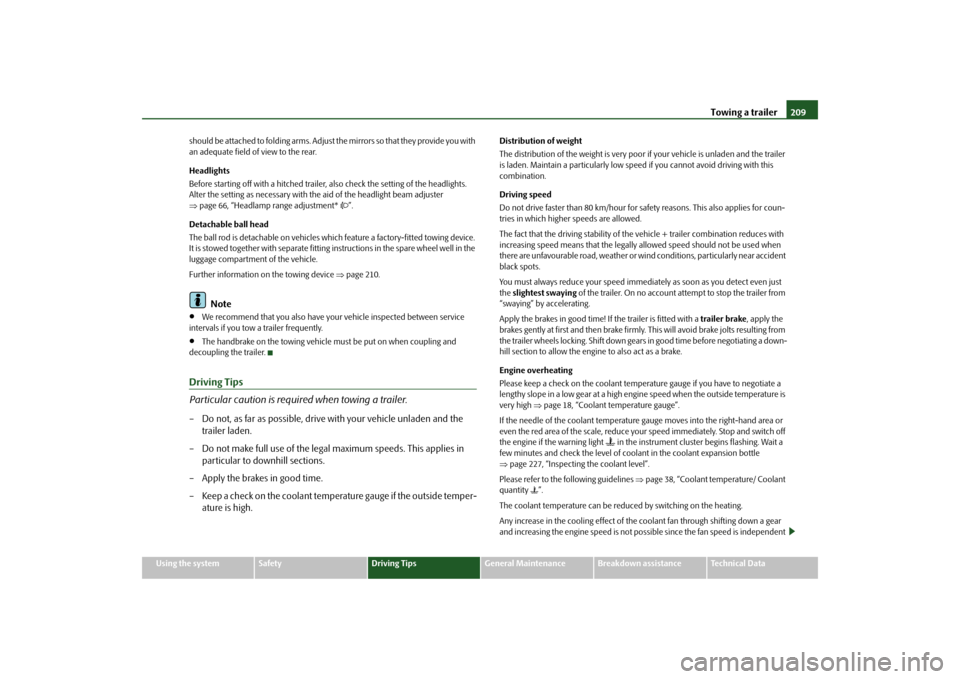
Towing a trailer
209
Using the system
Safety
Driving Tips
General Maintenance
Breakdown assistance
Technical Data
should be attached to folding arms. Adjust
the mirrors so that they provide you with
an adequate field of view to the rear. Headlights Before starting off with a hitched trailer, also check the setting of the headlights. Alter the setting as necessary with th
e aid of the headlight beam adjuster
⇒ page 66, “Headlamp range adjustment*
”.
Detachable ball head The ball rod is detachable on vehicles which feature a factory-fitted towing device. It is stowed together with separate fitting instructions in the spare wheel well in the luggage compartment of the vehicle. Further information on the towing device
⇒page 210.
Note
•
We recommend that you also have yo
ur vehicle inspected between service
intervals if you tow a trailer frequently.•
The handbrake on the towing vehicle
must be put on when coupling and
decoupling the trailer.Driving Tips Particular caution is required when towing a trailer.– Do not, as far as possible, drive
with your vehicle unladen and the
trailer laden.
– Do not make full use of the legal maximum speeds. This applies in
particular to downhill sections.
– Apply the brakes in good time.– Keep a check on the coolant temper
ature gauge if the outside temper-
ature is high.
Distribution of weight The distribution of the weight is very poor
if your vehicle is
unladen and the trailer
is laden. Maintain a particularly low speed if you cannot avoid driving with this combination. Driving speed Do not drive faster than 80 km/hour for safety reasons. This also applies for coun- tries in which higher speeds are allowed. The fact that the driving stability of the vehicle + trailer combination reduces with increasing speed means that the legally allowed speed should not be used when there are unfavourable road, weather or wind
conditions, particul
arly near accident
black spots. You must always reduce your speed immedi
ately as soon as you detect even just
the
slightest swaying
of the trailer. On no account attempt to stop the trailer from
“swaying” by
accelerating.
Apply the brakes in good time! If the trailer is fitted with a
trailer brake
, apply the
brakes gently at first and then brake firmly
. This will avoid brake jolts resulting from
the trailer wheels locking. Shift down gears
in good time before negotiating a down-
hill section to allow the engine to also act as a brake. Engine overheating Please keep a check on the coolant temperature gauge if you have to negotiate a lengthy slope in a low gear at a high engine speed when the outside temperature is very high
⇒page 18, “Coolant temperature gauge”.
If the needle of the coolant temperature gauge moves into the right-hand area or even the red area of the scale, reduce yo
ur speed immediately. Stop and switch off
the engine if the warning light
in the instrument cluste
r begins flashing. Wait a
few minutes and check the level of coolant in the coolant expansion bottle ⇒ page 227, “Inspecting the coolant level”. Please refer to the following guidelines
⇒page 38, “Coolant temperature/ Coolant
quantity
”.
The coolant temperature can be reduced by switching on the heating.Any increase in the cooling effect of the coolant fan through shifting down a gear and increasing the engine speed is not possible since the fan speed is independent
s2dk.1.book Page 209 Wednesday, April 8, 2009 12:23 PM
Page 229 of 294
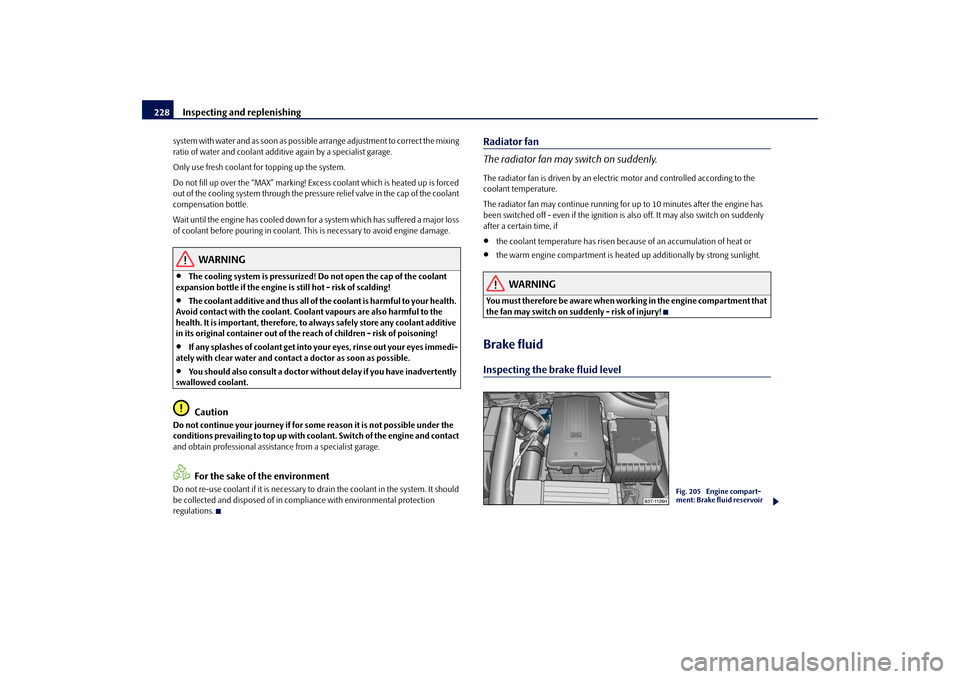
Inspecting and replenishing
228
system with water and as soon as possible
arrange adjustment to correct the mixing
ratio of water and coolant additive again by a specialist garage. Only use fresh coolant for topping up the system.Do not fill up over the “MAX” marking! Exce
ss coolant which is heated up is forced
out of the cooling system through the pressure relief valve in the cap of the coolant compensation bottle. Wait until the engine has cooled down for a system which has suffered a major loss of coolant before pouring in coolant. Th
is is necessary to
avoid engine damage.
WARNING
•
The cooling system is pressurized! Do not open the cap of the coolant
expansion bottle if the engine is still hot - risk of scalding!•
The coolant additive and thus all of the coolant is harmful to your health.
Avoid contact with the coolant. Coolant vapours are also harmful to the health. It is important, therefore, to always safely store any coolant additive in its original container out of the reach of children - risk of poisoning!•
If any splashes of coolant get into yo
ur eyes, rinse out your eyes immedi-
ately with clear water and contact
a doctor as soon as possible.
•
You should also consult a doctor without delay if you have inadvertently
swallowed coolant.
Caution
Do not continue your journey if for some reason it is not possible under the conditions prevailing to top up with coolant. Switch of the engine and contact
and obtain professional assistan
ce from a specialist garage.
For the sake of the environment
Do not re-use coolant if it is necessary to
drain the coolant in the system. It should
be collected and disposed of in comp
liance with environmental protection
regulations.
Radiator fan The radiator fan may switch on suddenly.The radiator fan is driven by an electric motor and controlled according to the coolant temperature. The radiator fan may continue running for
up to 10 minutes after the engine has
been switched off - even if the ignition is
also off. It may al
so switch on suddenly
after a certain time, if•
the coolant temperature has risen because of an accumulation of heat or
•
the warm engine compartment is heated
up additionally by strong sunlight.
WARNING
You must therefore be aware when work
ing in the engine compartment that
the fan may switch on suddenly - risk of injury!Brake fluidInspecting the brake fluid level
Fig. 205 Engine compart- ment: Brake fluid reservoir
s2dk.1.book Page 228 Wednesday, April 8, 2009 12:23 PM
Page 287 of 294
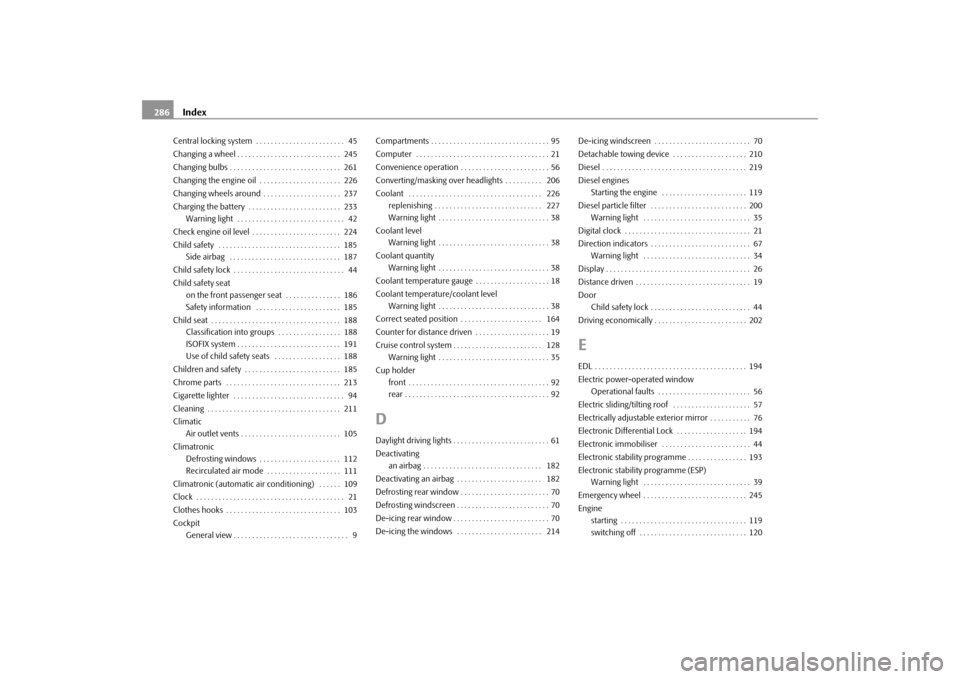
Index 286Central locking system . . . . . . . . . . . . . . . . . . . . . . . . 45
Changing a wheel . . . . . . . . . . . . . . . . . . . . . . . . . . . . 245
Changing bulbs . . . . . . . . . . . . . . . . . . . . . . . . . . . . . . 261
Changing the engine oil . . . . . . . . . . . . . . . . . . . . . . 226
Changing wheels around . . . . . . . . . . . . . . . . . . . . . 237
Charging the battery . . . . . . . . . . . . . . . . . . . . . . . . . 233
Warning light . . . . . . . . . . . . . . . . . . . . . . . . . . . . . 42
Check engine oil level . . . . . . . . . . . . . . . . . . . . . . . . 224
Child safety . . . . . . . . . . . . . . . . . . . . . . . . . . . . . . . . . 185
Side airbag . . . . . . . . . . . . . . . . . . . . . . . . . . . . . . 187
Child safety lock . . . . . . . . . . . . . . . . . . . . . . . . . . . . . . 44
Child safety seat
on the front passenger seat . . . . . . . . . . . . . . . 186
Safety information . . . . . . . . . . . . . . . . . . . . . . . 185
Child seat . . . . . . . . . . . . . . . . . . . . . . . . . . . . . . . . . . . 188
Classification into groups . . . . . . . . . . . . . . . . . 188
ISOFIX system . . . . . . . . . . . . . . . . . . . . . . . . . . . . 191
Use of child safety seats . . . . . . . . . . . . . . . . . . 188
Children and safety . . . . . . . . . . . . . . . . . . . . . . . . . . 185
Chrome parts . . . . . . . . . . . . . . . . . . . . . . . . . . . . . . . 213
Cigarette lighter . . . . . . . . . . . . . . . . . . . . . . . . . . . . . . 94
Cleaning . . . . . . . . . . . . . . . . . . . . . . . . . . . . . . . . . . . . 211
Climatic
Air outlet vents . . . . . . . . . . . . . . . . . . . . . . . . . . . 105
Climatronic
Defrosting windows . . . . . . . . . . . . . . . . . . . . . . 112
Recirculated air mode . . . . . . . . . . . . . . . . . . . . 111
Climatronic (automatic air conditioning) . . . . . . 109
Clock . . . . . . . . . . . . . . . . . . . . . . . . . . . . . . . . . . . . . . . . 21
Clothes hooks . . . . . . . . . . . . . . . . . . . . . . . . . . . . . . . 103
Cockpit
General view . . . . . . . . . . . . . . . . . . . . . . . . . . . . . . . 9Compartments . . . . . . . . . . . . . . . . . . . . . . . . . . . . . . . . 95
Computer . . . . . . . . . . . . . . . . . . . . . . . . . . . . . . . . . . . . 21
Convenience operation . . . . . . . . . . . . . . . . . . . . . . . . 56
Converting/masking over headlights . . . . . . . . . . 206
Coolant . . . . . . . . . . . . . . . . . . . . . . . . . . . . . . . . . . . . 226
replenishing . . . . . . . . . . . . . . . . . . . . . . . . . . . . . 227
Warning light . . . . . . . . . . . . . . . . . . . . . . . . . . . . . . 38
Coolant level
Warning light . . . . . . . . . . . . . . . . . . . . . . . . . . . . . . 38
Coolant quantity
Warning light . . . . . . . . . . . . . . . . . . . . . . . . . . . . . . 38
Coolant temperature gauge . . . . . . . . . . . . . . . . . . . . 18
Coolant temperature/coolant level
Warning light . . . . . . . . . . . . . . . . . . . . . . . . . . . . . . 38
Correct seated position . . . . . . . . . . . . . . . . . . . . . . 164
Counter for distance driven . . . . . . . . . . . . . . . . . . . . 19
Cruise control system . . . . . . . . . . . . . . . . . . . . . . . . 128
Warning light . . . . . . . . . . . . . . . . . . . . . . . . . . . . . . 35
Cup holder
front . . . . . . . . . . . . . . . . . . . . . . . . . . . . . . . . . . . . . . 92
rear . . . . . . . . . . . . . . . . . . . . . . . . . . . . . . . . . . . . . . . 92
DDaylight driving lights . . . . . . . . . . . . . . . . . . . . . . . . . . 61
Deactivating
an airbag . . . . . . . . . . . . . . . . . . . . . . . . . . . . . . . . 182
Deactivating an airbag . . . . . . . . . . . . . . . . . . . . . . . 182
Defrosting rear window . . . . . . . . . . . . . . . . . . . . . . . . 70
Defrosting windscreen . . . . . . . . . . . . . . . . . . . . . . . . . 70
De-icing rear window . . . . . . . . . . . . . . . . . . . . . . . . . . 70
De-icing the windows . . . . . . . . . . . . . . . . . . . . . . . 214De-icing windscreen . . . . . . . . . . . . . . . . . . . . . . . . . . 70
Detachable towing device . . . . . . . . . . . . . . . . . . . . 210
Diesel . . . . . . . . . . . . . . . . . . . . . . . . . . . . . . . . . . . . . . . 219
Diesel engines
Starting the engine . . . . . . . . . . . . . . . . . . . . . . . 119
Diesel particle filter . . . . . . . . . . . . . . . . . . . . . . . . . . 200
Warning light . . . . . . . . . . . . . . . . . . . . . . . . . . . . . 35
Digital clock . . . . . . . . . . . . . . . . . . . . . . . . . . . . . . . . . . 21
Direction indicators . . . . . . . . . . . . . . . . . . . . . . . . . . . 67
Warning light . . . . . . . . . . . . . . . . . . . . . . . . . . . . . 34
Display . . . . . . . . . . . . . . . . . . . . . . . . . . . . . . . . . . . . . . . 26
Distance driven . . . . . . . . . . . . . . . . . . . . . . . . . . . . . . . 19
Door
Child safety lock . . . . . . . . . . . . . . . . . . . . . . . . . . . 44
Driving economically . . . . . . . . . . . . . . . . . . . . . . . . . 202
EEDL . . . . . . . . . . . . . . . . . . . . . . . . . . . . . . . . . . . . . . . . . 194
Electric power-operated window
Operational faults . . . . . . . . . . . . . . . . . . . . . . . . . 56
Electric sliding/tilting roof . . . . . . . . . . . . . . . . . . . . . 57
Electrically adjustable exterior mirror . . . . . . . . . . . 76
Electronic Differential Lock . . . . . . . . . . . . . . . . . . . 194
Electronic immobiliser . . . . . . . . . . . . . . . . . . . . . . . . 44
Electronic stability programme . . . . . . . . . . . . . . . . 193
Electronic stability programme (ESP)
Warning light . . . . . . . . . . . . . . . . . . . . . . . . . . . . . 39
Emergency wheel . . . . . . . . . . . . . . . . . . . . . . . . . . . . 245
Engine
starting . . . . . . . . . . . . . . . . . . . . . . . . . . . . . . . . . . 119
switching off . . . . . . . . . . . . . . . . . . . . . . . . . . . . . 120
s2dk.1.book Page 286 Wednesday, April 8, 2009 12:23 PM